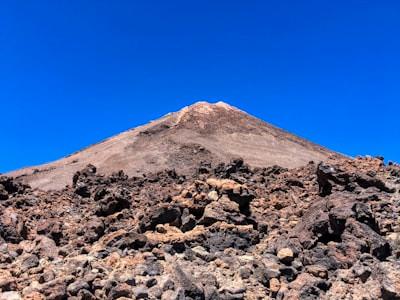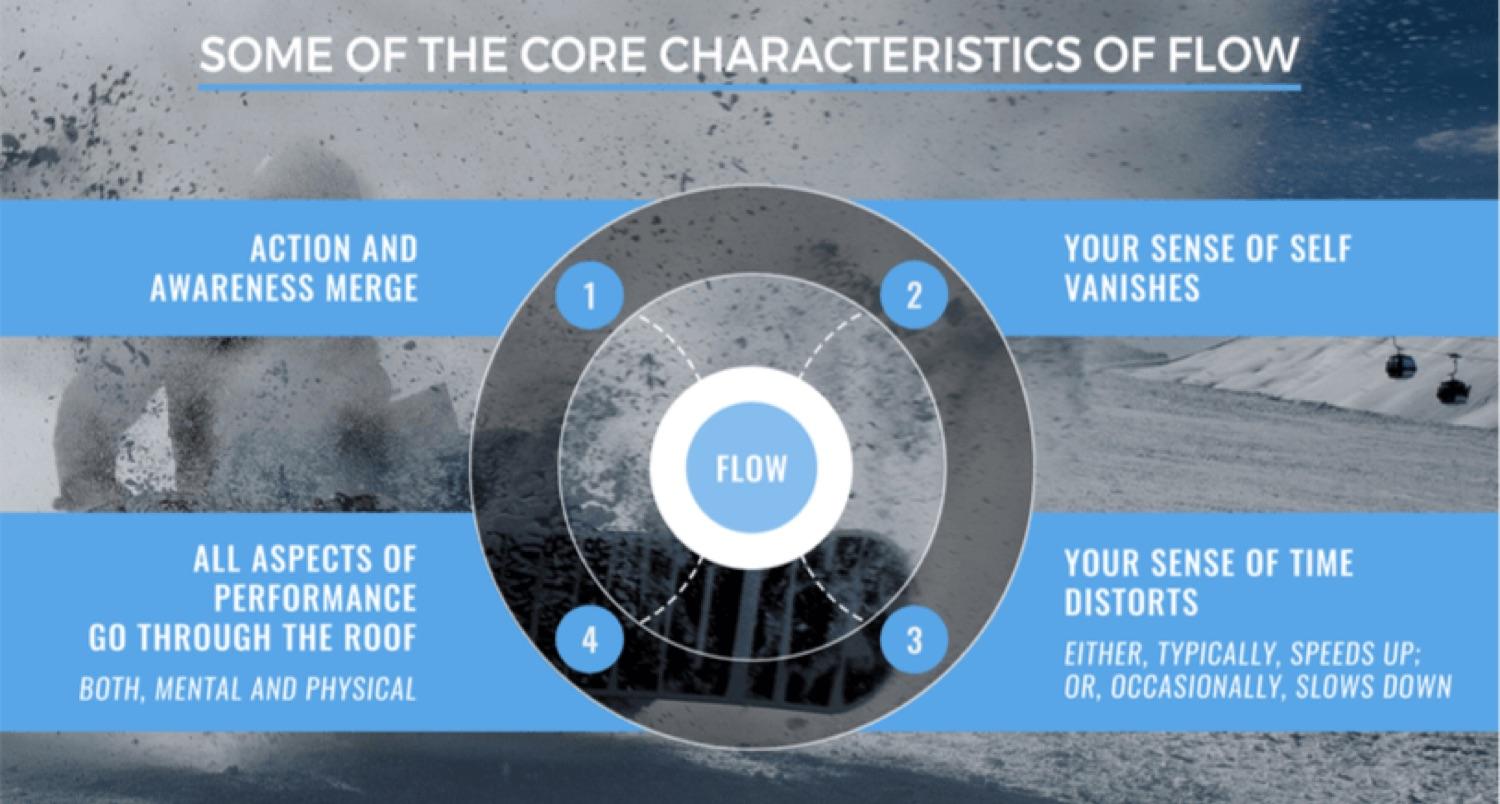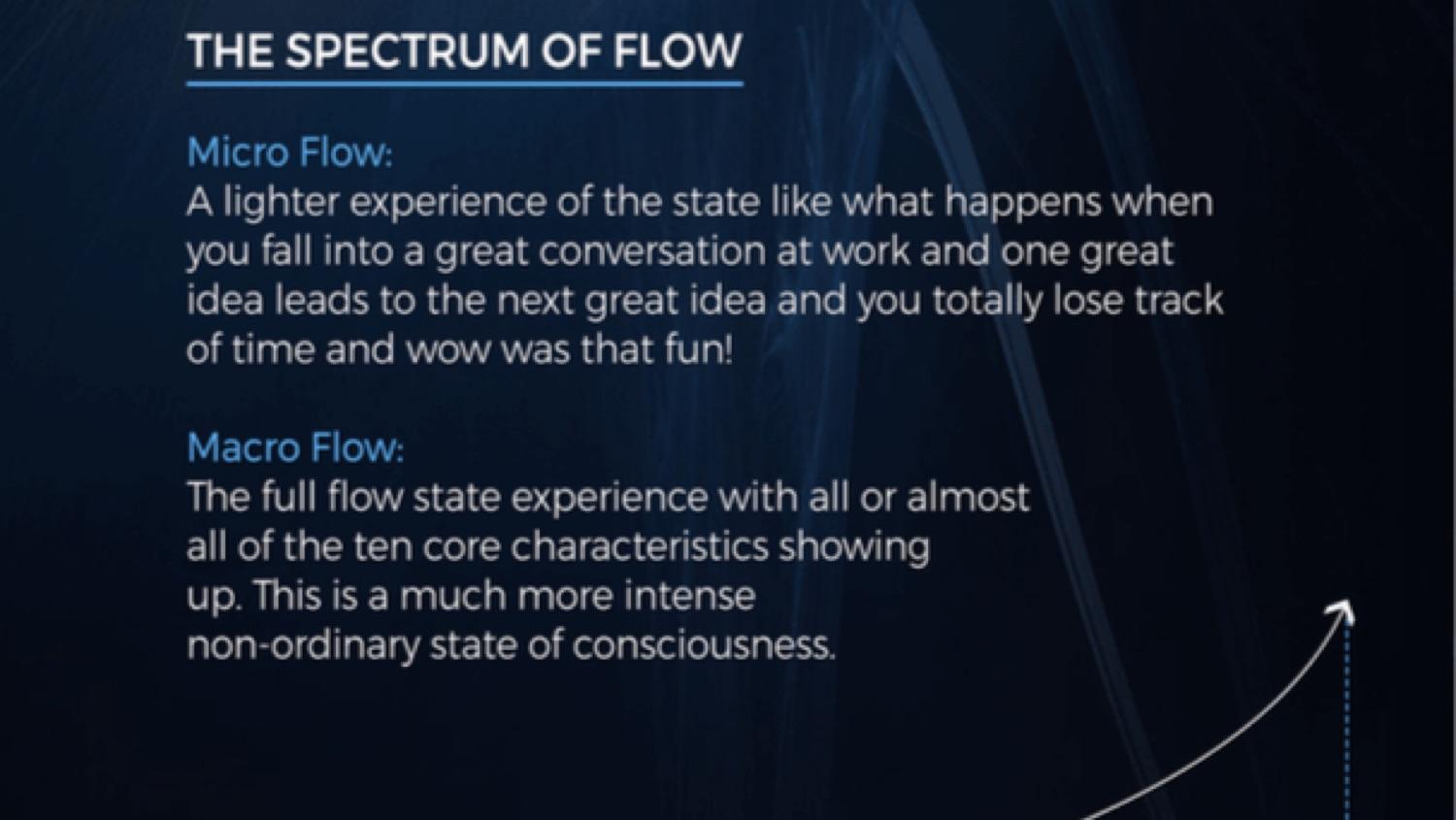FAQs on Flow
Curated from: stevenkotler.com
Ideas, facts & insights covering these topics:
14 ideas
·784 reads
7
Explore the World's Best Ideas
Join today and uncover 100+ curated journeys from 50+ topics. Unlock access to our mobile app with extensive features.
What Is A General Definition On Flow?
Flow is defined as an optimal state of consciousness, a state where you feel your best and perform your best. More specifically, the term refers to those moments of rapt attention and total absorption, when you get so focused on the task at hand that everything else disappears. Action and awareness merge. Your sense of self vanishes. Your sense of time distorts (either, typically, speeds up; or, occasionally, slows down). And throughout, all aspects of performance, both mental and physical, go through the roof.
14
107 reads
Where Does The Word “Flow” Come From Anyway?
The synonyms for flow are endless: peak experiences, being in the zone, runner’s high, being unconscious, the forever box, etc. Flow is something of a technical term. It emerged from psychologist Mihaly Csikszentmihalyi’s early research into the state, where interview subjects—in one of the largest psychological surveys ever conducted— consistently described the experience of flow as one where every decision, every action, flows seamlessly, perfectly, effortlessly. The term “flow” actually describes how the state makes us feel. In short, flow feels flowy.
12
66 reads
How The Hell Do I Know If I’m “In Flow”?
The research of Csikszentmihalyi and a few other scientists uncovered 10 core characteristics that underpin the state. While each of these phenomena can be experienced independently, when they all show up together—that’s flow. Or, at least, that’s the original idea. The researchers behind Flow Genome Project deviate slightly from this notion. While they absolutely agree that the first 6 of these characteristics constitute flow, they’re not yet convinced the last 4 (intense concentration, immediate feedback, clear goals, and the challenge/skills ratio) are characteristics of the state.
12
68 reads
Flow’s 10 Core Characteristics
1. Action and Awareness Merge. The doer and the doing become one. From the perspective of consciousness, we become the action. In other words, actions feel automatic and require little or no additional resources.
2. Selflessness. Our sense of self disappears. Our sense of self-consciousness as well. The inner critic is silenced.
3. Timelessness. We experience an altered perception of time. Past and future disappear and we are plunged into an eternal present, a deep now.
15
65 reads
Flow’s 10 Core Characteristics
4. Effortlessness. Our sense of struggle and strife vanishes. The experience becomes intrinsically-rewarding or—in technical parlance—“autotelic.”
5. Paradox of Control. We have a powerful sense of control over the situation. We are captain of our own ship; master of this small slice of destiny.
6. Intrinsic Motivation. The experience is intrinsically motivating. We do it for love not money. We do it because the activity itself is so incredibly enthralling that it’s its own reward.
14
56 reads
Flow’s 10 Core Characteristics
7. Intense Concentration. More specifically, intense concentration on a limited field of information. Total focus on the right here, right now. Complete absorption in the present moment.
8. Challenge/Skills Balance. The challenge of the task at hand slightly exceeds our skill set so we have to push ourselves outside our comfort zone. But not too far outside. We have to stretch, not snap.
12
51 reads
Flow’s 10 Core Characteristics
9. Clear Goals. These are not big goals (like winning the Olympics in downhill skiing), rather they are much smaller chunks (like getting out of the starting gate fast). What’s critical is we know what we’re doing now and we know what we’re doing next so attention can stay focused in the present.
10. Immediate Feedback. The gap between cause and effect is tiny—so we can always course-correct mid-flight.
12
50 reads
Are There Different Kinds Of Flow?
Yes. Flow comes in two kinds—individual and group. When someone uses the term “flow” they’re describing an individual performing at their very peak. The term “group flow” refers to the shared, collective experience of the state: a group performing at their peak. For a great look at flow, check out Csikszentmihalyi’s book Flow. For a great look at group flow, check out Keith Sawyer’s book, Group Genius.
12
49 reads
Are There Varying Degrees Of Flow?
Yes. Flow is a spectrum experience. It’s like anger. You can be a little mad or homicidally murderous: same emotion, different degrees. Csikszentmihalyi and Susan Jackson discovered that the same thing is true of flow. You can be in a state of micro-flow—like what happens when you fall into a great conversation at work and one great idea leads to the next great idea and you totally lose track of time; or you can experience a state of macro-flow, where all of flow’s core characteristics show up so strongly that the experience itself takes on otherworldly, quasi-mystical qualities.
12
44 reads
What’s A “Flow Trigger”?
Flow states have triggers, or pre-conditions that lead to more flow. Essentially, flow can only arise when all of our attention is focused in the present moment, so that’s what these triggers do—they drive attention into the here and now. Put differently, these triggers are the very things that evolution shaped our brain to pay the most attention to, so, in using these triggers to hack flow, we’re really just using evolutionary biology to our advantage.
13
50 reads
Which Are The “Flow Triggers”?
Csikszentmihalyi identified 4 of these triggers (though he argued they’re characteristics of flow and not triggers of flow). Research by the Flow Genome Project shows that when skillfully deployed (see The Rise of Superman for details), these “characteristics” consistently generate more flow and are better classified as “triggers.”
- Complete Concentration in the Present Moment
- Immediate Feedback
- Clear Goals
- The Challenge-Skills Ratio (that is, the challenge of the task at hand stretches our skills to the outmost).
14
42 reads
Group Flow Triggers
University of North Carolina psychologist Keith Sawyer extended this original list, identifying ten triggers that produce “group flow.”
1. Shared Goals (everyone in the group is working towards the same end)
2. Close Listening (you’re paying complete attention to what is being said)
3. Yes And (conversations are additive, not combative)
4. Complete Concentration (total focus in the right here, right now)
5. A sense of control (each member of the group feels in control, but still flexible)
14
42 reads
Group Flow Triggers
6. Blending Egos (each person can submerge their ego needs into the group’s)
7. Equal Participation (skills levels are roughly equal everyone is involved)
8. Familiarity (people know one another and understand their tics and tendencies)
9. Constant Communication (a group version of immediate feedback)
10. Shared, Group Risk (everyone has some skin in the game)
13
46 reads
More Triggers…?
Research with both artists and action and adventure sports athletes have fingered four more triggers (see Rise of Superman for a more detailed breakdown).
1. High consequences (that is, some kind of risk: physical, mental, social, emotional, etc.)
2. Deep Embodiment (the engagement of multiple sensory streams at once, learning through doing)
3. Rich Environment (lots of novelty, complexity, and unpredictability in the environment)
4. Creativity (specifically, pattern recognition, or the linking together of new ideas)
14
48 reads
IDEAS CURATED BY
CURATOR'S NOTE
The process of flow was discovered and coined by the Hungarian-American psychologist Mihaly Csikszentmihalyi. In the 1960s, Csikszentmihalyi studied the creative process and found that, when an artist was in the course of flow, they would persist at their task relentlessly, regardless of hunger or fatigue. He also found that the artist would lose interest after the project was completed, highlighting the importance of the process and not the end result.
“
Xarikleia 's ideas are part of this journey:
Learn more about problemsolving with this collection
How to strengthen your willpower
How to overcome temptation and distractions
The role of motivation in willpower
Related collections
Similar ideas
7 ideas
6 Keys to Reaching a State of Flow and Be More Creative
exploringyourmind.com
6 ideas
What's the flow state about?
bigthink.com
12 ideas
How To Reach Flow State
medium.com
Read & Learn
20x Faster
without
deepstash
with
deepstash
with
deepstash
Personalized microlearning
—
100+ Learning Journeys
—
Access to 200,000+ ideas
—
Access to the mobile app
—
Unlimited idea saving
—
—
Unlimited history
—
—
Unlimited listening to ideas
—
—
Downloading & offline access
—
—
Supercharge your mind with one idea per day
Enter your email and spend 1 minute every day to learn something new.
I agree to receive email updates


